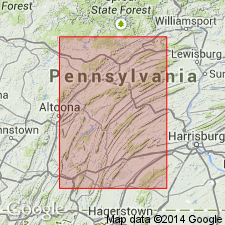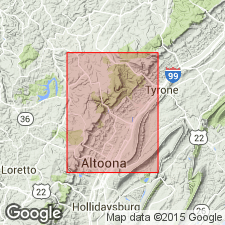
- Usage in publication:
-
- New Enterprise member
- Modifications:
-
- Named
- Dominant lithology:
-
- Limestone
- Metabentonite
- AAPG geologic province:
-
- Appalachian basin
Summary:
Named the New Enterprise member of the Salona formation for the New Enterprise quarry near Roaring Spring, Blair Co., central PA. Composed of calcirudite that as a whole is characterized by lack of apparent sedimentary structure, aphanitic texture, and nearly black color. Calcirudite beds are 6 inches to 1 foot thick and make up more than 95 percent of unit. Six metabentonite beds are recognized. Thickness of member is 90 feet at type locality. Conformably underlies the Roaring Springs member of the Nealmont limestone. The New Enterprise is of Middle Ordovician age.
Source: GNU records (USGS DDS-6; Reston GNULEX).

- Usage in publication:
-
- New Enterprise Member
- Modifications:
-
- Overview
- AAPG geologic province:
-
- Appalachian basin
Summary:
Salona Formation is recognized throughout the Valley and Ridge province in central PA and in the subsurface in western PA, northwestern VA, and eastern WV. Unit is predominantly a dark-gray limestone containing thin interbeds of black calcareous shale. New Enterprise Member (lower member) consists of an interbedded sequence of dark-gray to grayish-black homogeneous calcisiltite and calcareous shale. Beds are nearly nonfossiliferous, with only rare brachiopods and trilobites. Five ash beds present in this member. Upper Roaring Spring Member is distinguished from lower member by the presence of ripples and cross-bedding in calcisiltite and calcarenite. One ash bed present in Roaring Spring. Salona gradationally overlies Rodman Formation and conformably underlies the Coburn Formation. Thickness of 55+/-5 m measured at the New Enterprise Stone and Gravel Company quarry at Roaring Spring. New Enterprise Member is 38 m, while the Roaring Spring Member is 18 m. No basis given for the Late Ordovician age assignment.
Source: GNU records (USGS DDS-6; Reston GNULEX).
For more information, please contact Nancy Stamm, Geologic Names Committee Secretary.
Asterisk (*) indicates published by U.S. Geological Survey authors.
"No current usage" (†) implies that a name has been abandoned or has fallen into disuse. Former usage and, if known, replacement name given in parentheses ( ).
Slash (/) indicates name conflicts with nomenclatural guidelines (CSN, 1933; ACSN, 1961, 1970; NACSN, 1983, 2005, 2021). May be explained within brackets ([ ]).

